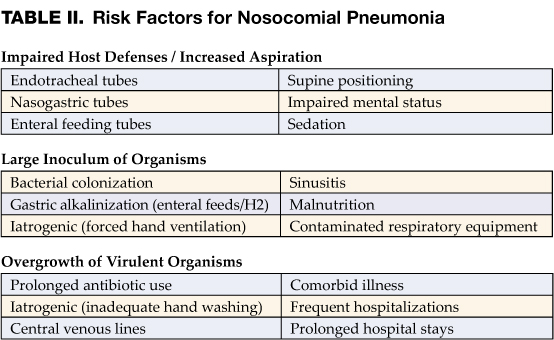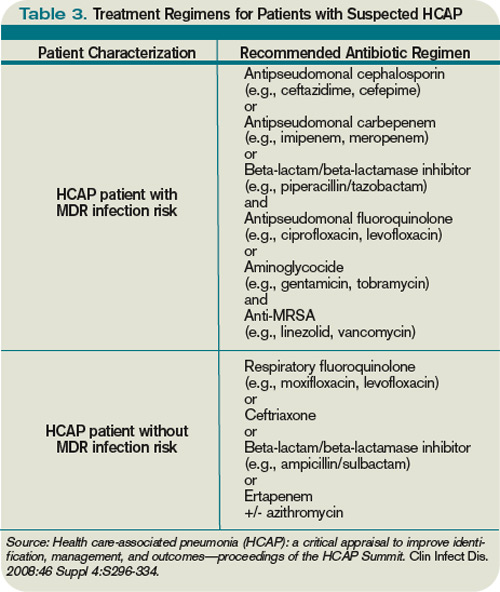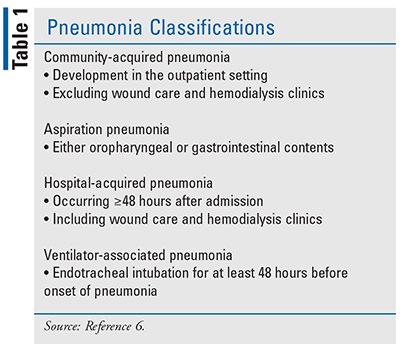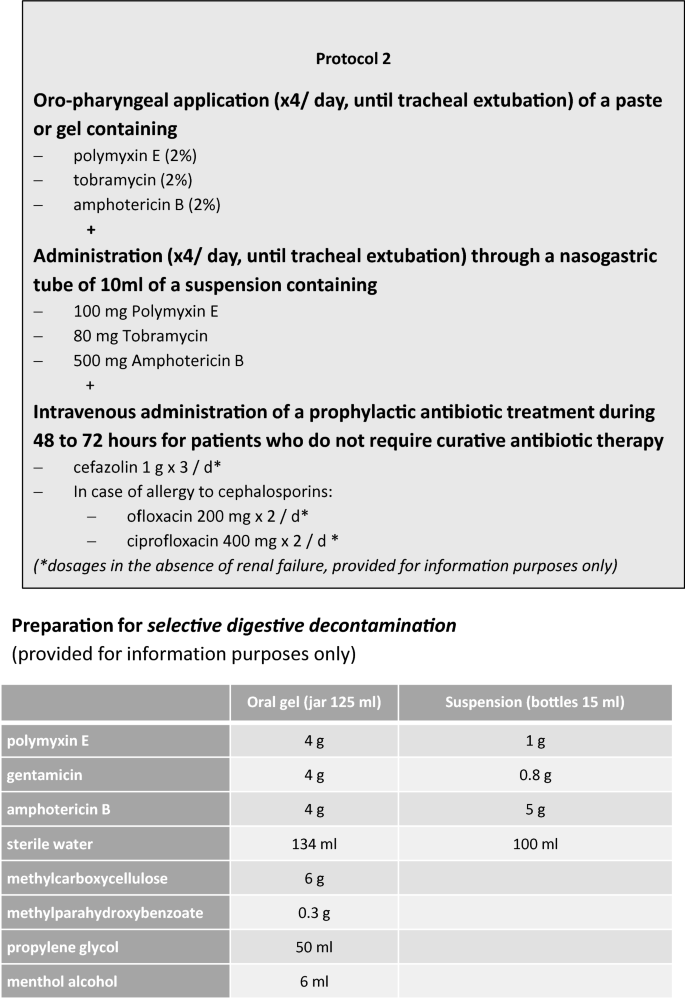Hospital-acquired pneumonia HAP is an acute lower respiratory tract infection that is by definition acquired after at least 48 hours of admission to hospital and is not incubating at the time of admission. Kalil AC Metersky ML Klompas M et al.
Plos One Comparison Of Viral Infection In Healthcare Associated Pneumonia Hcap And Community Acquired Pneumonia Cap

Nosocomial Pneumonia The Hospitalist

What Is The Best Initial Treatment Of An Adult Patient With Healthcare Associated Pneumonia The Hospitalist
CAP is common affecting people of all ages and its symptoms occur as a result.

Healthcare acquired pneumonia. Community-acquired pneumonia CAP is defined as pneumonia acquired outside hospital or healthcare facilities. Management of Adults With Hospital-acquired and Ventilator-associated Pneumonia. Community-acquired pneumonia CAP refers to pneumonia any of several lung diseases contracted by a person outside of the healthcare system.
2016 clinical practice guidelines by. These healthcare-associated infections HAIs include central line-associated bloodstream infections catheter-associated urinary tract infections and ventilator-associated pneumonia. Hospital-acquired pneumonia HAP and ventilator-associated pneumonia VAP cause significant inpatient morbidity and mortality.
Pneumonia Pressure ulcers Prevention and control of healthcare-associated infections Sedation in children and young people Sepsis Tobacco use Transition between community or care home and inpatient mental health settings. As disease presentation varies from a mild illness that can be managed as an outpatient to a severe illness requiring treatment in the intensive care unit ICU determining the appropriate level of care is important for improving outcomes in addition to. Symptoms and signs are fever cough sputum production pleuritic chest.
Community Acquired Pneumonia Clinical Pathway All Settings Childrens Hospital of Philadelphia. This care process model CPM is maintained by Intermountain Healthcares Lower Respiratory Tract Infection Team a subgroup of the Intensive Medicine Clinical Program. Healthcare settings include hospitals long-term care facilities and dialysis centers.
HAP is the second most common nosocomial infection after urinary tract. Hospital-acquired or nosocomial pneumonia HAP is pneumonia that occurs 48 hours or more after admission and did not appear to be incubating at the time of admission. Community-acquired pneumonia CAP an infection of the lung parenchyma that occurs in persons outside of a hospital setting is associated with high morbidity and mortality.
Clinical diagnosis is based on a group of signs and symptoms related to lower respiratory tract infection with presence of fever 38ºC 100ºF cough mucopurulent sputum pleuritic chest pain dyspnoea and new focal chest signs on. The term Hospital-acquired Pneumonia or HAP has replaced HCAP. Community-acquired pneumonia is when someone develops pneumonia in the community not in a hospital.
2 A recent study projected that CAP results in 15. Management of adults with hospital-acquired and ventilator-associated pneumonia. It does not cover ventilatorassociated pneumonia.
Hospital-acquired pneumonia HAP develops at least 48 hours after hospital admission. A healthcare-acquired infection HAI is an infection contracted in a healthcare facility such as an acute care hospital or a skilled nursing care facility. Healthcare-associated pneumonia is when someone develops pneumonia during or following a stay in a healthcare setting.
It aims to optimise antibiotic use and reduce antibiotic resistance. It is responsible for one fourth of all ICU. Healthcare-acquired Pneumonia or HCAP which was widely used previously has been made obsolete.
Kalil AC Metersky ML Klompas M et al. Ventilator-associated pneumonia VAP is a type of HAP that develops more than 48 hours after endotracheal intubation. They are especially challenging to diagnose promptly in the intensive care unit because a plethora of other causes can contribute to clinical decline in complex critically ill patients.
The authors describe the diagnosis management and. The CPM summarizes and updates evaluation and treatment recommendations for community-acquired pneumonia CAP in immunocompetent patients 18 years and older. 2016 Clinical Practice Guidelines by the Infectious Diseases.
This guideline sets out an antimicrobial prescribing strategy for community-acquired pneumonia. Hospital-acquired pneumonia HAP is the leading cause of death among patients with hospital-acquired infections. As per the IDSA guidelines Hospital-acquired Pneumonia is defined as pneumonia that occurs 48 hours or more after admission to the hospital and did not appear to be incubating at the time of.
Community-acquired pneumonia is defined as pneumonia that is acquired outside the hospital. It aims to optimise antibiotic use and reduce antibiotic resistance. 1 In 2016 pneumonia was the primary diagnosis in more than 17 million patient visits to emergency departments in the United States.
In contrast hospital-acquired pneumonia HAP is seen in patients who have recently visited a hospital or who live in long-term care facilities. The medical community calls HAIs nosocomial infections. Pneumonia is among the leading causes of morbidity and mortality worldwide.
The term Hospital-acquired Pneumonia or HAP has replaced HCAP. 1-3 Although HAP is not a reportable illness available data suggest that it occurs at a rate of between 5 and 10 cases per 1000 hospital admissions with the incidence increasing by as much as 6-to 20-fold in mechanically ventilated patients. Community-acquired pneumonia is a leading cause of hospitalization mortality and incurs significant health care costs.
The setting in which pneumonia is acquired heavily infl. Community-acquired infections develop outside a healthcare facility. For recommendations on identifying and treating hospital-acquired bacterial pneumonia secondary to COVID-19.
As per the IDSA guidelines Hospital-acquired Pneumonia is defined as pneumonia that occurs 48 hours or more after admission to the hospital and did not appear to be incubating at the time of admission. Infections may also occur at surgery sites known as surgical site infections. The most commonly identified pathogens are Streptococcus pneumoniae Haemophilus influenzae atypical bacteria ie Chlamydia pneumoniae Mycoplasma pneumoniae Legionella species and viruses.
Hospital-acquired pneumonia HAP ventilator-associated pneumonia VAP and healthcare-associated pneumonia HCAP remain important causes of morbidity and mortality despite advances in antimicrobial therapy better supportive care modalities and the use of a wide-range of preventive measures 15. Healthcare-acquired Pneumonia or HCAP which was widely used previously has been made obsolete. Even a doctors office or clinic can be a source for an HAI.
Antibiotic-resistant organisms are an important concernSymptoms and signs include malaise fever chills rigor cough dyspnea and chest pain. Guidelines for the management of adults with hospital-acquired ventilator-associated and healthcare-associated pneumonia. The most common pathogens are gram-negative bacilli and Staphylococcus aureus.
It is thus distinguished from community-acquired pneumoniaIt is usually caused by a bacterial infection rather than a virus. The pneumonia clinical pathway aids clinicians in determining the appropriate steps to be taken when evaluating and treating a child with community-acquired pneumonia. Hospital-acquired pneumonia ventilator-associated pneumonia and health careassociated pneumonia represent the second most common nosocomial infections in the United States.
Hospital-acquired pneumonia HAP or nosocomial pneumonia refers to any pneumonia contracted by a patient in a hospital at least 4872 hours after being admitted. Hospital-acquired pneumonia on average increases the length of hospital stay from 7 to 9 days at an additional cost of more than 40000 per patient. Am J Respir Crit Care Med 2005.
For recommendations on community-acquired pneumonia secondary to COVID-19 see our rapid guideline on managing acute COVID-19. Although Streptococcus pneumoniae is the most likely cause in most cases the variety of potential pathogens can make choosing a management strategy a complex endeavor.

Identification Of Streptococcus Pneumoniae In Hospital Acquired Pneumonia In Adults Journal Of Hospital Infection
Hospital Acquired And Icu Pneumonia Infectious Disease And Antimicrobial Agents

Efficacy And Accuracy Of Qsofa And Sofa Scores As Prognostic Tools For Community Acquired And Healthcare Associated Pneumonia International Journal Of Infectious Diseases

Burden Of Community Acquired Pneumonia Is Borne By Older Adults

Summary Of The International Clinical Guidelines For The Management Of Hospital Acquired And Ventilator Acquired Pneumonia European Respiratory Society

Brief Summary Of French Guidelines For The Prevention Diagnosis And Treatment Of Hospital Acquired Pneumonia In Icu Annals Of Intensive Care Full Text

Strategies To Reduce Non Ventilator Associated Hospital Acquired Pneumonia A Systematic Review Infection Disease Health

Healthcare Acquired Pneumonia Hcap Patient Backgrounds Download Table
